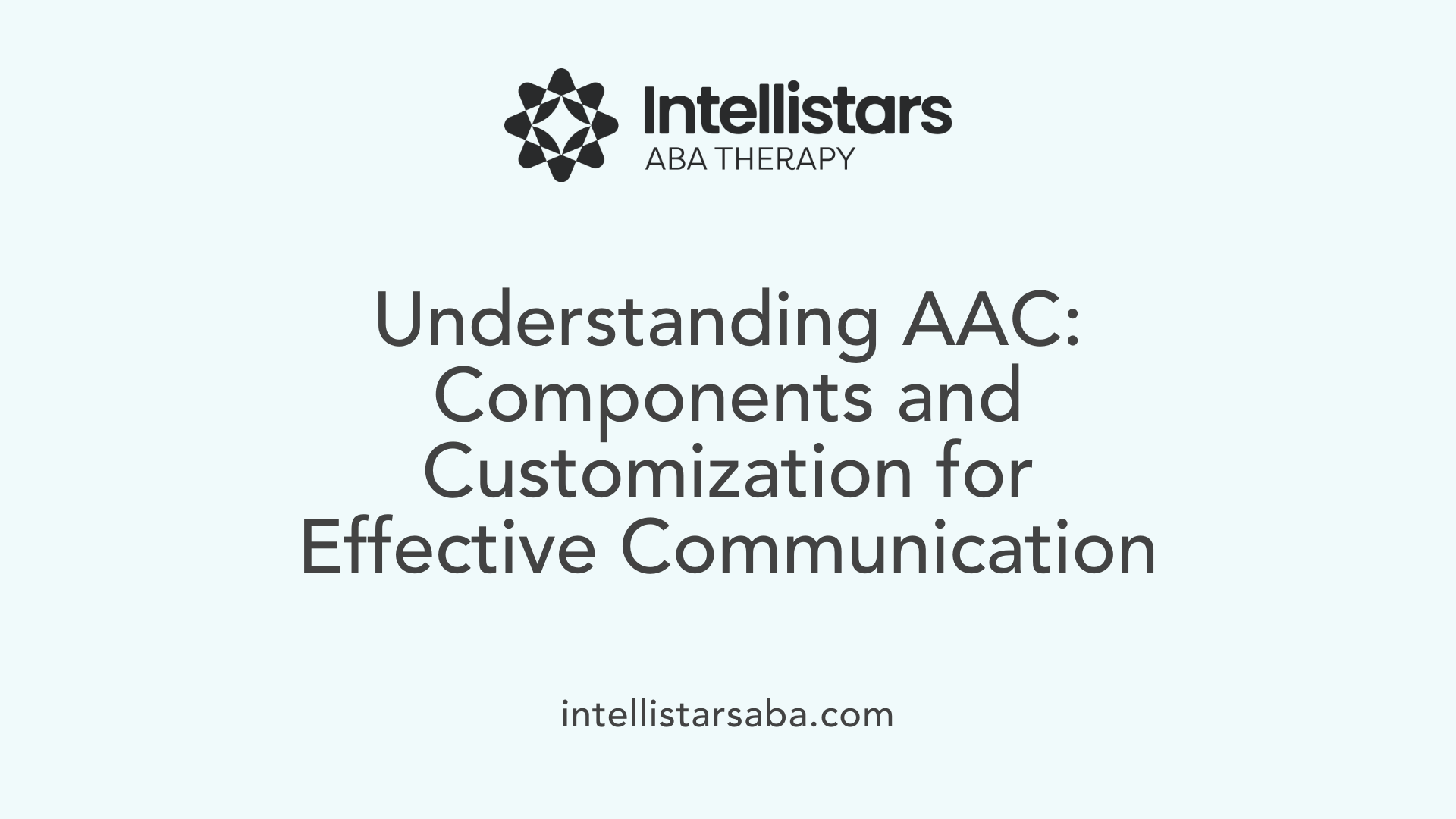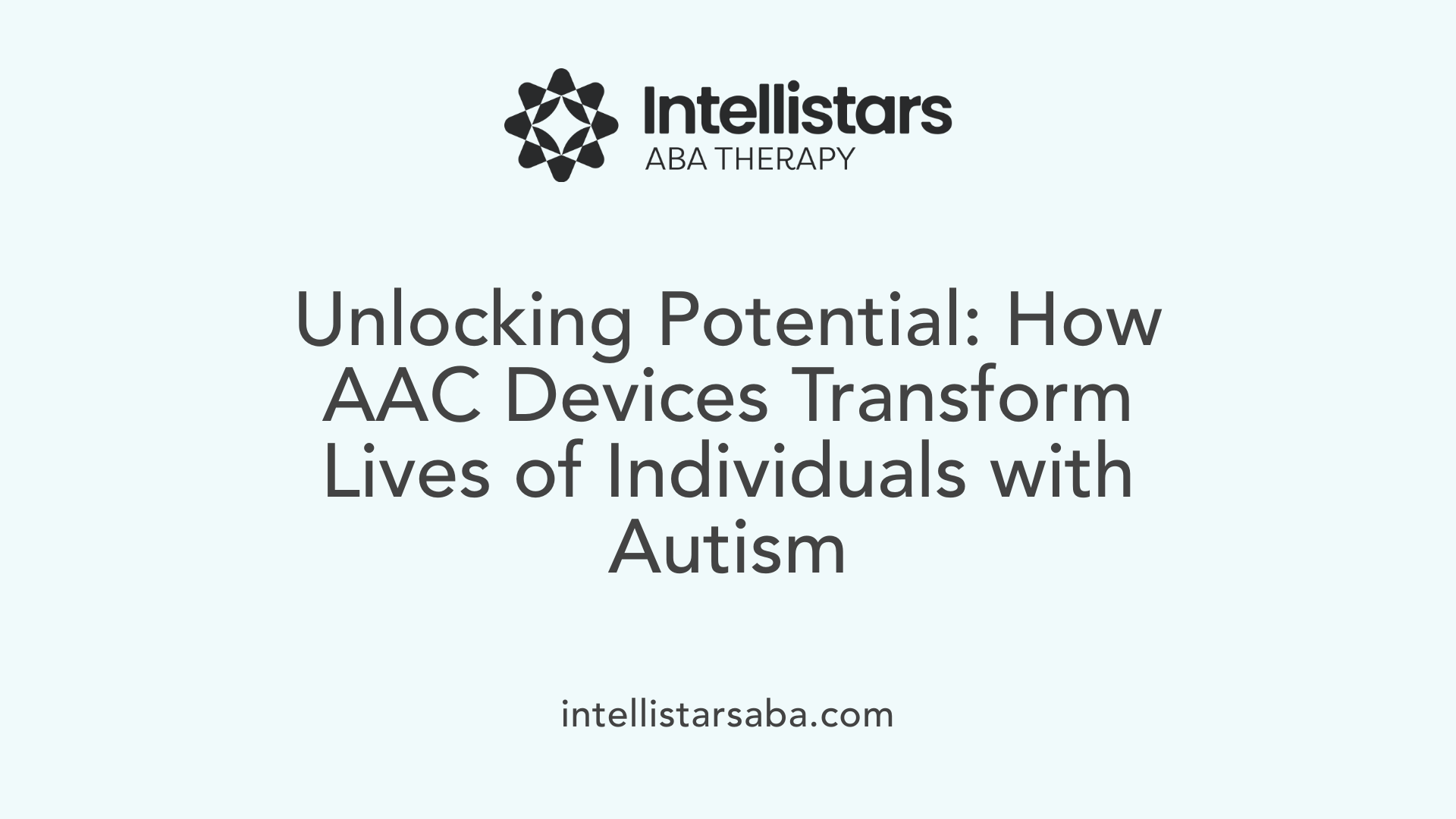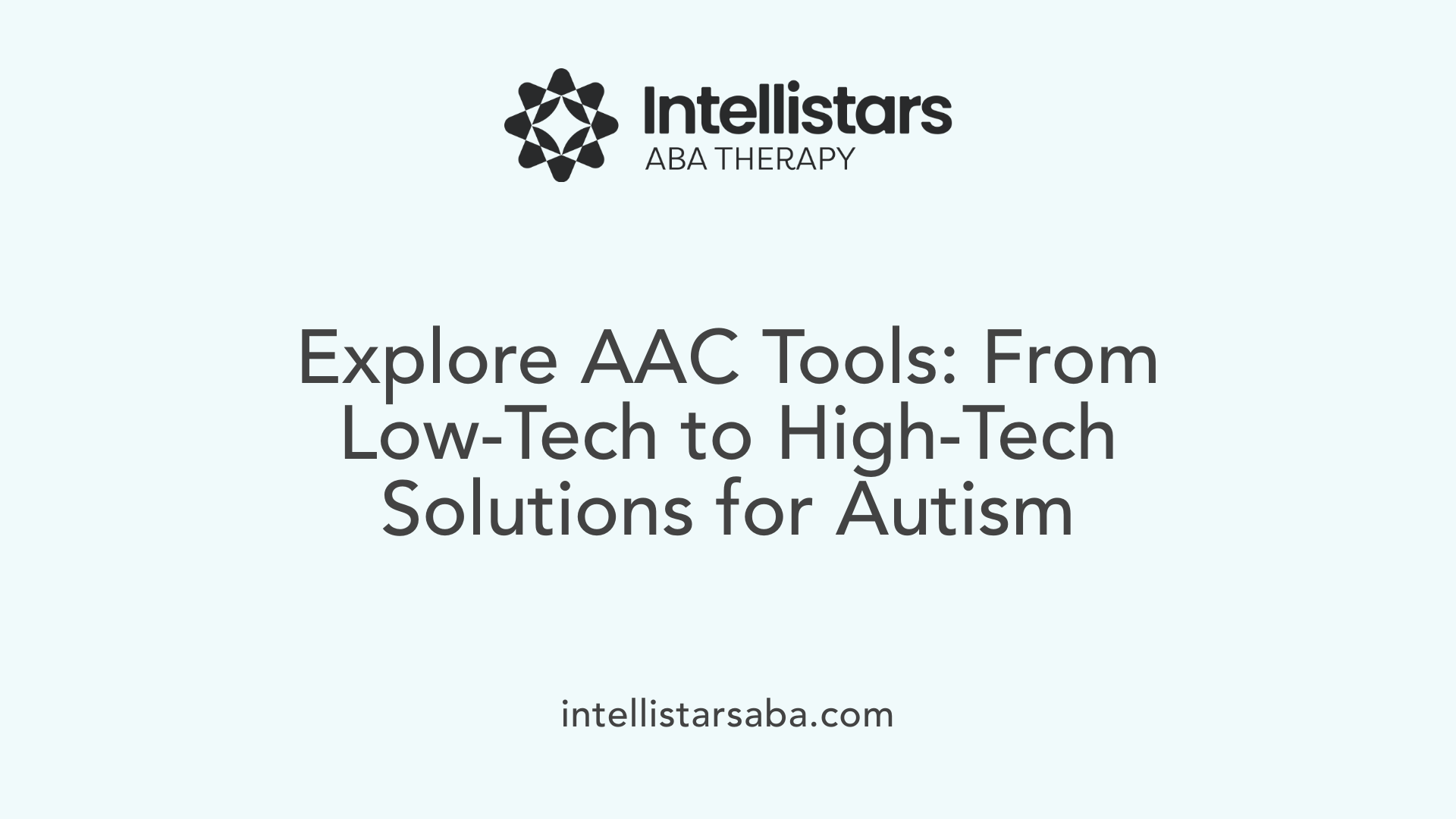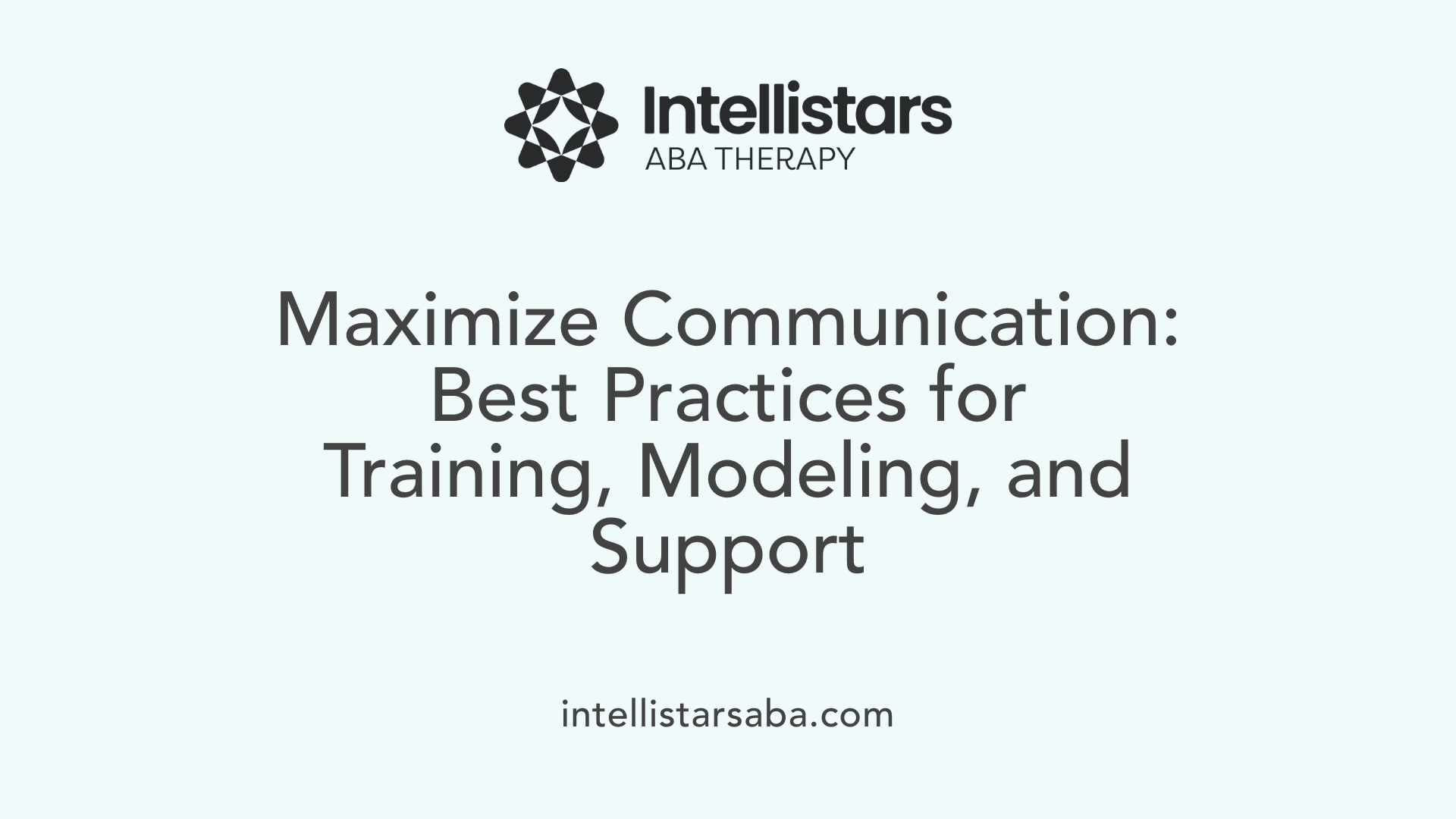Understanding AAC Devices and Their Role in Autism
Augmentative and Alternative Communication (AAC) devices are vital tools that enhance communication for individuals with autism who face challenges with speech and language. These systems, which can range from simple picture boards to sophisticated electronic devices, serve to supplement or replace spoken language, empowering users to express their needs, desires, and emotions effectively. As awareness and technology improve, AAC devices are becoming more accessible and tailored to individual needs, offering new avenues for social interaction, independence, and emotional well-being.
Defining AAC Devices and Their Components

What does AAC stand for?
Augmentative and Alternative Communication (AAC) refers to a variety of methods and tools used by individuals who have difficulty communicating verbally. These methods include pictures, gestures, sign language, written words, and electronic devices designed to support or replace speech. AAC helps ensure that everyone has the opportunity to express their needs, thoughts, and feelings, promoting independence and social inclusion.
What are the types of AAC (unaided and aided)?
AAC tools are classified into two main categories:
- Unaided AAC: These methods do not require external devices and rely on the person’s body movements. Examples include gestures, facial expressions, American Sign Language, and vocalizations.
- Aided AAC: These involve external tools or devices to communicate. They include communication boards, picture exchange systems, spelling books, and high-tech speech-generating devices such as tablets with specific applications.
Both types can be tailored to fit an individual’s abilities and preferences, often used together to maximize communication effectiveness.
Examples of AAC tools
Here are some common AAC tools used for children and adults alike:
| Tool Type | Example | Description |
|---|---|---|
| Low-tech | Picture Exchange Communication System (PECS) | Uses picture cards to help request or label objects and actions. |
| Low-tech | Communication Boards or Books | Feature symbols, pictures, or words for pointing or selecting. |
| Mid-tech | Speech Buttons | Electronic buttons that say words or phrases when pressed. |
| High-tech | Tablets with Communication Apps | Devices like iPads loaded with apps such as Proloquo2Go, which generate speech from typed or selected symbols. |
| High-tech | Dedicated Speech-Generating Devices | Standalone devices designed specifically for communication, often with features like eye gaze control or tactile access. |
These tools range from simple, low-cost picture cards to advanced electronic systems, allowing choices based on individual skills, needs, and preferences. Proper assessment with professionals like speech-language pathologists is essential to select appropriate AAC devices that support effective communication.
Purpose, Benefits, and Impact of AAC Devices

Why are AAC devices important for individuals with autism?
AAC devices play a vital role in supporting individuals with autism by offering alternative ways to communicate effectively. They enable clear expression of needs, thoughts, and emotions, which can significantly reduce frustration and behavioral challenges stemming from miscommunication or inability to express oneself.
These tools foster greater independence, allowing users to participate more actively in social interactions, learn routines, and build relationships. Furthermore, research indicates that using AAC does not hinder speech development; instead, it can promote verbal skills and enhance receptive language abilities.
By enhancing communication, AAC devices improve social inclusion and overall quality of life, empowering autistic individuals to contribute more fully within their communities.
What benefits do AAC devices provide for autistic individuals?
The benefits of AAC extend across multiple areas of development and daily living. These include:
- Facilitating effective communication of needs and wants
- Supporting social engagement and participation
- Reducing emotional distress caused by communication barriers
- Reinforcing language acquisition and literacy skills
- Promoting independence in daily activities
- Allowing access to educational and community environments
Customizable to each person's abilities and preferences, AAC tools motivate learning and help reinforce newly acquired skills. They can also improve emotional well-being, happiness, and overall development, making daily life and social integration more accessible and enjoyable.
Overall, AAC devices serve as powerful tools that support the growth, social connection, and autonomy of individuals with autism, contributing positively to their overall life experience.
Assessment, Selection, and Use of AAC Devices
When should a child get an AAC device?
A child should be considered for an AAC device as early as 10 months if they have difficulty with communication, experience frequent breakdowns in interactions, or cannot effectively express their needs and feelings. Early intervention with AAC helps support essential language development, reduces frustration, and encourages social and emotional growth.
Introducing AAC at a young age complements speech development efforts and provides visual and multimedia tools to facilitate understanding and interaction. These systems are adaptable and can be used at any age, whether as a temporary support during recovery or as a long-term communication aid.
Who qualifies for an AAC device?
Anyone experiencing challenges with speech or language can qualify for an AAC system, regardless of age. This includes children, adolescents, and adults with conditions like autism, cerebral palsy, intellectual disabilities, or sensory impairments.
The process of qualification involves comprehensive assessment by speech-language pathologists and other professionals. They evaluate an individual’s abilities, communication needs, and environmental factors to select or customize appropriate AAC tools. This tailored approach maximizes communication effectiveness and promotes independence.
Role of speech-language Pathologists
Speech-language pathologists (SLPs) play an essential role in AAC assessment and implementation. They evaluate communication skills, motor abilities, and cognitive levels to determine the most suitable AAC system. SLPs also provide training on device use, teach communication strategies, and support ongoing development.
Their expertise ensures that the chosen device complements existing skills and adapts as the individual grows or their needs change. SLPs also coordinate with families, educators, and other therapists for a holistic approach.
Steps to acquire and implement AAC
Acquiring and implementing AAC involves several steps:
- Assessment: Conducted by professionals, including speech-language pathologists and occupational therapists, to understand communication strengths and challenges.
- Device Selection: Choosing suitable tools, which can range from low-tech picture boards to high-tech speech-generating devices.
- Trial and Training: Testing devices with the individual, offering training sessions for users and caregivers, and adjusting features to ensure proper fit.
- Implementation: Integrating the AAC system into daily routines at home, school, and community settings.
- Follow-Up: Ongoing monitoring and support, including device updates, skill reinforcement, and troubleshooting.
Importance of modeling and support
Consistent modeling by caregivers, teachers, and peers is vital for successful AAC use. Demonstrating how to use the device, creating opportunities for interaction, and allowing ample time for communication enhance learning.
Support also involves providing encouragement, troubleshooting technical issues, and ensuring the device is always accessible. Regular practice and positive reinforcement help embed AAC into everyday communication.
Integration with other therapies
AAC is most effective when integrated with other therapies such as behavioral interventions, literacy instruction, and social skills training. This comprehensive approach addresses broader developmental goals and fosters generalization of communication skills.
Professionals coordinate efforts to align AAC use with therapy goals, ensuring that communication supports are embedded across all activities. This synergy encourages more natural, spontaneous use of AAC and enhances overall progress.
Types and Features of AAC Devices for Autism Support

What are some examples of AAC devices used for autism?
Autism support through AAC includes a range of devices, from high-tech speech-generating hardware to simple picture cards. Popular high-tech options are devices like NovaChat by PRC-Saltillo, Tobii Dynavox, and AbleNet QuickTalker. These devices often feature customizable vocabularies, tactile buttons, eye-gaze control, and multimedia integration, making them highly adaptable to individual needs.
Tablet-based applications, such as Proloquo2Go, also serve as versatile AAC solutions. These apps can be personalized with symbols, text, and speech output, allowing users to communicate effectively in many settings. On the other hand, low-tech tools like Picture Exchange Communication System (PECS), communication boards, and sign language remain valuable, especially for those with motor challenges or preference for non-electronic tools.
What are the features and modifications available in AAC devices?
Modern AAC devices come equipped with features tailored to support diverse communication needs. Customization options include vocabulary selection, social scripts, and the addition of multimedia content like videos and images, helping to reinforce learning.
Functional features include dynamic screens that change based on context, tactile feedback through raised symbols or textured buttons, and durability for everyday use. Accessibility options are also crucial; devices often support multiple modes of access such as eye gaze, switches, or touch, accommodating various motor abilities.
Many devices, including Lingraphica’s TouchTalk Plus and NovaChat, support social stories and video modeling. These features help teach life skills, social interactions, and routines. The ability to personalize icons, words, phrases, and scripts ensures each device meets the specific preferences and developmental level of the user.
| Device Model | Features | Accessibility Options | Special Capabilities |
|---|---|---|---|
| NovaChat | Custom vocabulary, multimedia, social scripts | Eye gaze, switches | Durable, social stories |
| Tobii Dynavox | Dynamic screens, video support | Eye gaze, touch | Environmental control |
| Lingraphica TouchTalk | Voice output, customizable vocab | Switch access, touchscreen | Reinforcement programs |
Supporting customization and versatile features ensures that AAC devices continue to evolve, providing improved communication avenues for individuals with autism.
Overcoming Challenges and Ensuring Effective Use

What are the best practices for training, modeling, and ongoing support?
Effective use of AAC relies on consistent training and support. Professionals such as speech-language pathologists, occupational therapists, and educators play a crucial role in teaching users how to operate their devices. Modeling involves caregivers and therapists demonstrating how to use the system during everyday interactions, helping the individual learn through imitation.
Ongoing support includes regular check-ins to adjust the device, troubleshoot issues, and reinforce communication strategies. Providing ample opportunities for the individual to practice and encouraging use across different settings boosts confidence and competence.
How can environmental consistency help?
A consistent environment enhances AAC effectiveness. This means using the same devices, symbols, and routines at home, school, and in the community. Consistent placement of the device, routine use during communication, and familiar symbols help users understand and predict how to communicate.
Creating predictable routines and ensuring the device is always accessible minimizes frustration and fosters independence. Consistency also extends to teaching others how to use and support AAC, creating a unified approach.
How do I address device limitations?
While AAC devices provide valuable support, they have limitations such as battery life, vocabulary restrictions, or physical accessibility challenges. To overcome these issues, select devices that include customizable vocabulary, multiple access methods (such as eye gaze or switches), and durability features.
It’s essential to work with professionals to tailor devices to the user’s needs, adjusting settings and adding new vocabulary as skills develop. Regular maintenance, updates, and backup plans ensure consistent communication.
Where can I buy AAC devices suitable for autism?
AAC devices suitable for autism can be purchased through specialized vendors such as Lingraphica, Enabling Devices, and authorized online platforms. These suppliers offer a range of options, including high-tech speech-generating devices, app-based systems, and low-tech communication tools, often with trial periods, insurance support, and ongoing customer service to assist with selection and implementation.
What are the disadvantages of AAC devices?
Disadvantages include potential high costs, technical issues, limited vocabulary in some models, portability concerns, and the need for ongoing training and support. Some users may experience frustration if the device does not meet their specific needs or if there are technical difficulties. However, these challenges can often be mitigated through professional guidance, personalized settings, and consistent modeling by caregivers and therapists.
| Aspect | Potential Challenges | Solutions and Considerations |
|---|---|---|
| Device Cost | Expensive initial investment | Explore insurance, grants, and trial programs |
| Technical Issues | Malfunctions, software bugs | Regular updates, professional maintenance |
| Vocabulary Limitations | Restricted communication options | Customization, addition of personalized vocabulary |
| Portability Concerns | Difficulty carrying devices | Choose lightweight, durable options with portability features |
| Training Needs | User frustration, improper use | Professional training, modeling, ongoing support |
Using and troubleshooting AAC devices in autism support is an ongoing process that benefits greatly from collaboration among families, professionals, and technology providers. Accessible resources, training, and tailored support ensure that individuals gain maximum benefit from their AAC systems.
Empowering Communication and Inclusion
AAC devices are transformative tools that open pathways for individuals with autism to communicate effectively and participate fully in their communities. With advancements in technology, personalized options, and professional support, AAC is becoming an integral part of autism intervention strategies, fostering independence, social engagement, and emotional well-being. Early assessment and appropriate use are key to maximizing their benefits, making AAC an essential resource in supporting lifelong communication and human rights.
References
- What is Augmentative and Alternative Communication and how can ...
- Technology and Autism | Autism Speaks
- The Most Popular AAC Devices | TherapyWorks
- Why AAC? - The Center for AAC & Autism
- AAC Devices: What They Are and How You Can Get One For Your ...
- Augmentative and Alternative Communication (AAC) - ASHA
- [PDF] Autism and Augmentative Alternative Communication
- How AAC devices for autism empower communication - Lingraphica
- AAC: Augmentative and Alternative Communication for Autism






